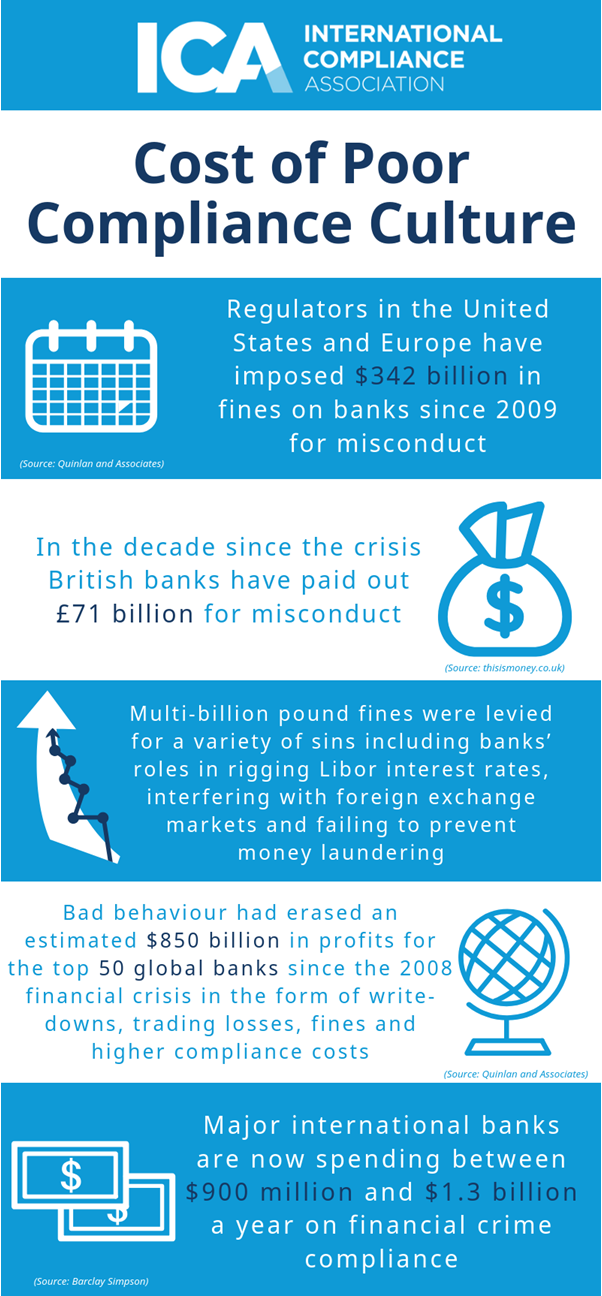Written by Jason Morris on Thursday 18 April, 2019
Culture is arguably the most beneficial asset a business can have: it can impact on performance, reputation, profit and growth in equal measure.
So much has been written about culture in recent years that we are in a position now where most businesses and business leaders understand its value. Compliance culture, especially in financial services, is a really important element that can impact on the wider cultural challenges that a firm could face.
There have been plenty of examples of how certain practices reflect a poor compliance culture that can negatively impact on a business. Back in 2012, the former UK regulator the FSA censured Bank of Scotland over serious deficiencies in its systems and controls, emanating from a corporate culture that ‘strongly focused on revenue rather than risk adjusted returns’. The bank even adjusted targets incentivising employees to regard ‘risk management as a constraint on the business rather than integral to it’.
Despite the fact that many regulators have made culture a key priority in their respective business plans for the industry, the intervening years have not eradicated poor compliance culture practices at prominent banking organisations.

A more recent example in the investment banking arm at Deutsche Bank shows a governance system which effectively creates internal competition. The various departments in the investment banking division have developed their own systems and processes that have resulted in a siloed way of working.
Each silo will lobby the sales team asking them to persuade the bank’s customers to trade its own products rather than those of its rivals. It is incredible to think that departments that operate within the same organisation would view one another as rivals, but this is exactly what is happening.
It is apparent, though, that Deutsche is well aware that its compliance culture needs to improve, and is making changes accordingly. Deutsche is also not alone here: many other organisations are suffering similar tests. Let us not forget the Forex manipulation case from a few years ago that involved several global players including Barclays, Citigroup, JP Morgan, UBS and The Royal Bank of Scotland, all of whom continue to face cultural challenges.
In fact, a lot of the fallout from the 2008 financial crisis, including Forex, has been the driving factor behind this focus on conduct and culture. Since the financial crisis, US banks have paid more than $200 billion in fines and settlements that specifically relate to questionable behaviour by financial institutions.
It is great that organisations are finally recognising the important role a positive compliance culture can have on its business. What remains now is for organisations to implement changes to encourage a positive culture to grow. Understanding that there is no quick-fix is important – widespread change within a single organisation can take time. What we are talking about here, though, is establishing widespread change across an entire industry, or even multiple industries (think VW emissions scandal).
The appetite is most definitely there, it is just that the pathway is perhaps a little unclear – so here are a few factors to take into account.
- Understand what the regulator's expectations are and keep pace with regulatory changes. Ensuring the regulatory function is properly resourced is crucial in this regard.
- Tone from the top is a term that has been around for a few years now, and it is as relevant now as is it ever was. If senior management set the correct tone of behaviour a positive tone will filter down to employees, demonstrating what is expected in terms of conduct on a daily basis.
- Employees must be properly trained on a firm’s internal policies and external
regulations, and this understanding should be reviewed periodically to embed the learning. - Adopting a mix of training techniques, including e-Learning, case studies and webinars, can ensure all employees have an opportunity to adopt a learning style that best suits individual needs.
- Reward employees for reflecting the firm’s culture in a positive way. It is a fact that employees will be more motivated to behave in a certain way if there is the potential for personal and professional gain.
- Promote an environment where employees feel comfortable reporting incidents. It is all about promoting transparency throughout the firm, making the employees feel as if they are all part of one team.
These are just a few ideas and they will vary from one business to the next in terms of how influential each one may be. Their impact in helping to develop a compliance culture is, however, unmistakable.
_________________________________________________________________
You might also like:
This article forms part of the #BigCompConvo - Join us as we explore and debate the latest challenges and issues facing you and regulatory and financial crime compliance professionals all over the world. If you’d like to contribute an article as part of the Big Compliance Conversation get in touch with us at contributions@int-comp.org


